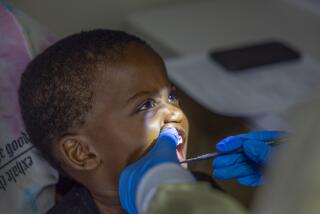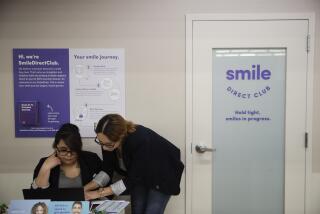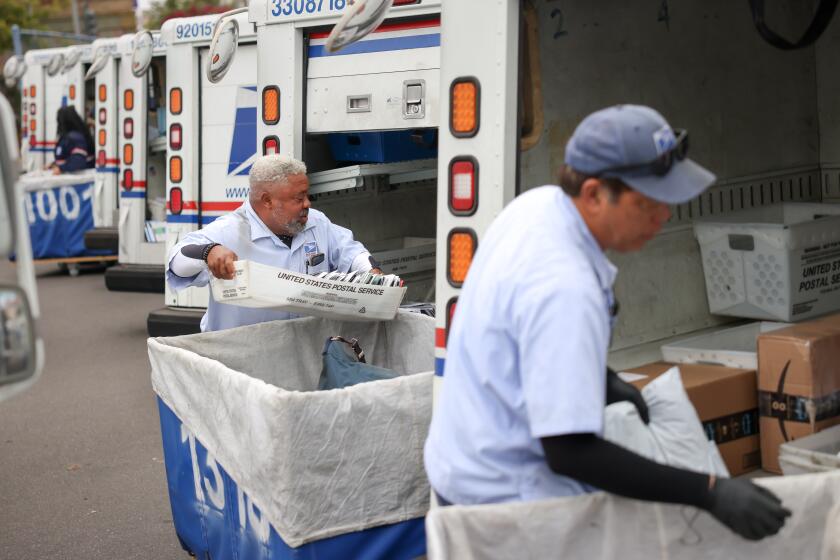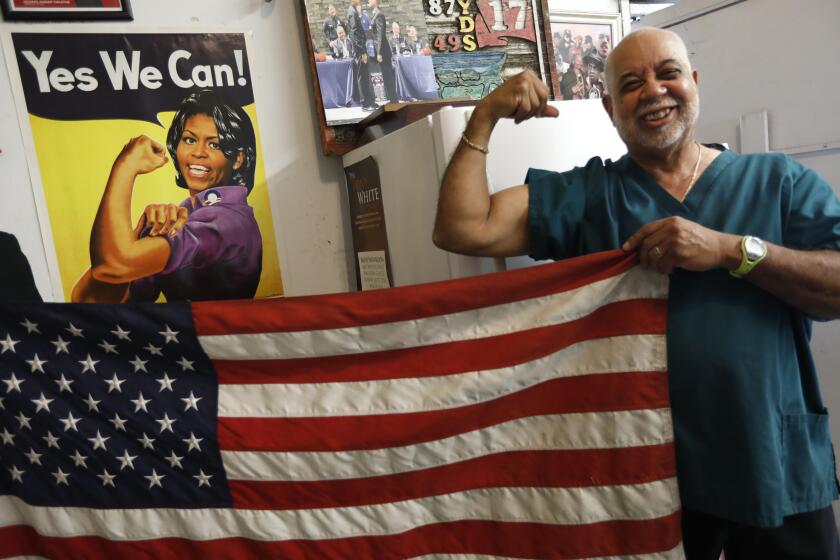A New Drill : New Regimen, High-Tech Advances Treat, Educate Dental Patients
- Share via
A burst of laughter escapes from Examining Room 4 in the Anaheim dental offices of Lee and Mark Metcalf.
Tracey Shaw, 20, is getting her teeth cleaned for the first time, and she’s finding the experience isn’t half bad.
Relaxed in a specially padded dental chair, Shaw clutches a remote-control box linked to the television perched in a corner of the office. Wearing headphones, she giggles at the antics on a “Saturday Night Live” tape while Mark Metcalf scrapes the tartar from her teeth. To the side of her chair, another television monitor displays the inside of Shaw’s mouth, in living color, via a camera pointed into her mouth. Metcalf politely asks Shaw to look at the pictures of her teeth for a moment so he can point out the tartar.
Metcalf instructs her on the importance of regular brushing and flossing to prevent tartar.
“Oh, yeah,” says the semi-impressed Shaw, returning to Bill Murray and company.
Since Shaw is a first-time dental patient blessed with healthy teeth, she wouldn’t know that a trip to the dentist’s office in the ‘90s is far different from even a few years ago.
Patients today will find dentists eager to educate with new devices, like the video cameras the father-son Metcalf team use to allow a patient to see what the dentist is seeing.
And fearful patients will find new techniques to help them relax, such as listening to music or watching movies.
Most of the environmental changes designed to educate the patient and ease fears are free to the patient. But patients are also facing new options to hasten treatment, prevent disease and eliminate pain. These include: tests for bacteria that cause gum disease, electrical stimulation for pain control, laser for use on soft tissues, and new materials to replace old silver fillings or restore worn teeth.
While the progress in dentistry is welcomed, there could be pitfalls for consumers who aren’t up on the changes.
How do you know if the newfangled treatment the dentist is offering you is frivolous or a true advance? And even if it’s good for you, will your dental insurance pay for it?
Robert L. Ibsen, a practicing dentist and founder of a Santa Maria-based supplier of cosmetic and restorative dental products, says consumers should recognize that even the experts debate the pros and cons of new treatments. Consumers should be prepared to ask questions.
“I like to ask the professional who is recommending something to me: What happens if I don’t have it done? What happens if I do have it done?” Ibsen says. “That enables you to get a feeling on how you want to approach something.”
Consumers might be most perplexed by a new test gaining popularity among dentists to diagnose periodontal disease.
The test, which is quick and painless, uses DNA technology to identify certain bacterium in the mouth that can lead to periodontal disease, or gum disease, says Joel Piehl, a Hollywood periodontist. Periodontal disease is an infectious disease caused by the accumulation of bacteria under the gum line.
The human mouth is loaded with bacteria. But in recent years, researchers have recognized that only a few types cause gum disease. The DNA test is the first to specifically identify the culprits, Piehl says.
In the past, dentists would look for symptoms such as bleeding gums or spaces between the gums and teeth as evidence for gum disease. But these symptoms are not always reliable indicators of disease, he says.
“In the past these (symptoms) were considered a pretty good indication of infection,” Piehl says. “You could assume that there would be a continual breakdown of bone and gum in the tooth around that area.”
But the new research shows “sometimes we can see bleeding and it doesn’t necessarily mean that the site is going to break down.”
Piehl says the test, which is marketed by Johnson & Johnson Dental Care, is not something that would be recommended for all patients as a screening device. He says he recommends it to about 10% of his patients who have some indication of gum disease.
To sample the bacteria, the dentist places a small paper point underneath the gum for 10 seconds, and then sends the paper strip to a lab.
“Then we can tell the patient we have clinical evidence of (infection),” he says. “On the other hand, we might say there are negative findings, even if we think the patient looks like he might have a problem.
“What this test has allowed us to do is be more honest in assessing that patient, more precise. It’s a wonderful improvement in our diagnostic skills.”
The DNA test usually costs about $50. At this time, most dental insurance plans will not cover it, Piehl says.
“We have probably 5% of plans that will pick it up,” he explains. “I hope that will change. We are advocating dental plans to pick this up.”
Another new technique that has created confusion for consumers is the use of lasers to treat some types of dental ailments.
Lasers are widely used in medicine. But in dentistry, lasers can only be used on soft tissue, such as gums, says Richard P. Mungo, head of the division of pediatric dentistry at Childrens Hospital of Los Angeles and a longtime researcher on lasers.
“When we do the surgery with laser there is no bleeding, very minimal--if any--post-operative discomfort and no post-operative infection,” Mungo says. “It’s very precise.”
The laser is now used to trim back gums and remove cysts, tumors or growths in the mouth. But lasers cannot yet be used to cut into teeth for such things as removing decay, Mungo says.
Some advertisements on dental lasers could mislead consumers about this, says Mungo, who is on a committee to set up guidelines for the use of lasers in dentistry.
“We knew once laser started to get out in the community that people would start to take advantage of it,” Mungo says.
Very few dentists are trained in use of laser and consumers should beware of extravagant claims, he adds.
“It’s very important that the public establish how much experience the dentist has and if he’s certified (to use a laser),” he says. “Ask how many cases he has done. If they are making exceptional claims--that it’s a panacea, that you won’t have pain, that it eliminates the need for the drill--if they are making it sound too good, it’s not the way to go. At this time, it’s quite limited to soft-tissue surgery.”
Laser equipment is very expensive and few dentists have it in their private offices. Most dentists share lasers in a hospital or surgical center, Mungo says. The treatment also costs more than traditional alternatives, and insurers rarely pay for the extra charges, he adds.
Still, Mungo predicts a bright future for lasers. Later this decade, researchers might perfect a laser to cut teeth.
“People have to be excited about it because some day we will do away with our drills and use laser to cut teeth. It’s not here today. But it’s really the wave of the future.”
Patients who especially fear pain might encounter dentists who are using a new technique called transcutaneous electrical nerve stimulation, or TENS, as an alternative to Novocain to deaden nerves.
By placing an electrode in the mouth of the patient, electrical signals appear to block pain perception by interrupting the ability of the brain to process pain sensations.
According to a study in the Journal of the American Dental Assn., the device was up to 90% effective in relieving pain associated with fillings. But the device is apparently too new for a consensus on its value.
The Metcalfs, for example, tried the device but dismissed it as ineffective.
“I didn’t feel it was as effective as local anesthesia,” says Lee Metcalf.
Many dentists agree that the use of new materials for restoring teeth is a significant advance. Some dentists are switching to tooth-colored composite materials instead of silver to fill cavities, says Ibsen.
“The real damaging part of silver filling is that the dentist can’t place it without damaging the tooth,” he says. “It’s only a matter of time before either the filling or the tooth breaks.”
The new materials may prove to be more reliable.
Another treatment using new materials is designed for patients with deterioration on their cuspid teeth, a process that occurs with normal aging.
When the cuspid teeth, or eye teeth, become worn, the bite can become out of alignment. A technique Ibsen devised called cuspid-guided occlusion involves placing small pieces of porcelain on the backs of the cuspids to guide the bite into proper alignment.
“We used to watch teeth wear out. Now we can we can put bonded porcelain to the teeth for restorative reasons,” he says. “We can stop wear, prevent wear and restore worn teeth.”
This is another procedure so new that few insurers will pay for it. But Ibsen thinks that will change as dentists prove the benefits associated with preventing problems.
“I think the real changes in our profession will not be in the area of cosmetic dentistry but in how we restore teeth,” he says.
More to Read
Sign up for Essential California
The most important California stories and recommendations in your inbox every morning.
You may occasionally receive promotional content from the Los Angeles Times.










